The creator economy is exploding. It’s creating incredible opportunities for digital entrepreneurs to build powerful brands and generate real income online. But beneath all the viral videos and major product launches, there’s a problem most people don’t talk about: when you’re running solo or working with a tiny team, creating consistent content becomes absolutely exhausting.
Here’s the thing: most guides about content operations are written for enterprise companies with dedicated content teams and massive budgets. That’s a problem for creators like you. Solo creators and small businesses face completely different challenges: limited time, tool overload, and a constant risk of burnout.
As a content creator and small business owner myself, I have more than a decade of experience in content operations that has led to building an infrastructure to start my own business. Now I want to share this experience with you.
In this article, I’m taking the concept of content operations and showing you how to apply it in a practical, creator-friendly way as I have done for my own brand. You’ll get a clear system to plan, create, publish, and measure your efforts across digital channels—without sacrificing your creative freedom or unique voice.
Why Creators Need Content Operations in 2026
The digital landscape today is more crowded than ever. More platforms. More formats. More content creators competing for attention in every niche imaginable. To succeed today, you need to treat your content like a real business, not just a creative hobby.
Without a proper content operations system in place, here’s what typically happens:
Tool chaos kills your productivity. You’re constantly jumping between Google Docs, Canva, Trello, Notion, and a dozen other apps. This fragmentation drains your focus and wastes valuable time.
Inconsistent publishing erodes trust. When you post randomly whenever you find time, your audience loses confidence in you. Your reach suffers. Your customer relationships weaken. Worse, inconsistent messaging across platforms confuses people about what you actually stand for.
You can’t identify what drives results. Some of your efforts generate sales, subscribers, or engagement, but you have no idea which pieces actually work. You lack the insights to understand what content marketing efforts are paying off and which are just noise. Without tracking customer acquisition costs, you’re essentially flying blind.
Burnout becomes inevitable. When you’re scrambling to create without systems or organization, exhaustion is a guarantee.
To stay competitive and grow your brand, you need to work smarter, not harder. With the right content operations framework—essentially a combination of people, processes, and technology—you can build systems that become your secret weapon.
5 Red Flags That Scream You Need Content Operations
Not sure if you actually need a formal system? Here are the warning signs that it’s time to get serious about content operations:
You’ve missed publishing deadlines three or more times this month. If you’re constantly scrambling at the last minute or skipping posts entirely, your lack of system is showing. Your audience notices these gaps, and algorithm penalties for inconsistency are real across all digital channels.
You can’t find files you created last week. Spending 15 minutes hunting for that Tuesday graphic? That’s fragmented digital asset management wasting hours every week. When you can’t locate your own work, you need better organization.
You’re recreating the same content types from scratch every single time. Writing identical Instagram captions over and over without templates? Redesigning similar thumbnails repeatedly? This is the clearest sign you need standardized content processes that save your creative energy for what actually matters.
You have absolutely no idea which content drives revenue. If someone asked, “Which three pieces generated the most sales last month?” and you can’t answer, you’re missing critical insights. You’re creating in the dark without understanding customer acquisition costs—and that’s expensive.
You feel guilty every time you take a day off. When your entire content system lives in your head, rest feels impossible. If you can’t step away without everything falling apart, you don’t have a sustainable business—you have a job you can’t quit.
Sound familiar? Don’t worry. The fact that you’re reading this article means you’re already on the path to fixing these problems. Let’s keep going.
What Is Content Operations? (A Simple Definition for Creators)
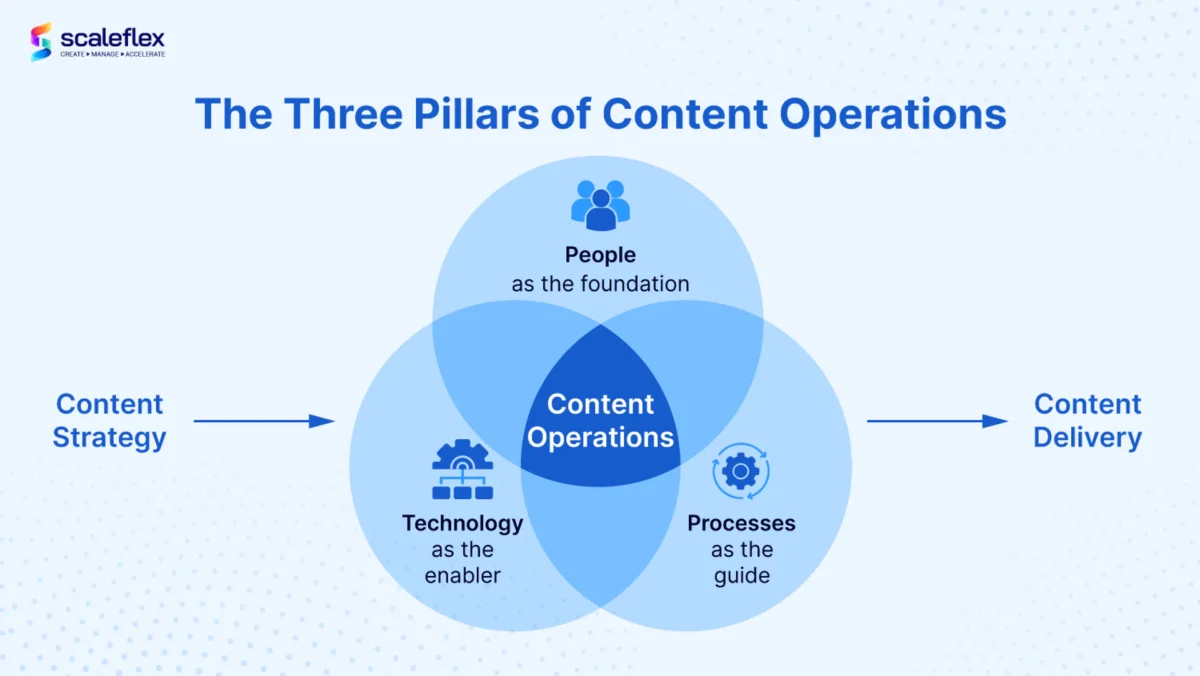 Source
SourceIn enterprise organizations, content operations refers to managing everything that makes content work: people, processes, technology, and governance. It’s the complete infrastructure that helps content teams create and publish material in a coordinated, efficient way.
But creators don’t need enterprise complexity. For solo creators and small businesses, content operations is simply a smart system that connects your content strategies, creative process, and publishing tools into one cohesive content workflow.
Is Your LinkedIn Working?
Just released: my new book to help professionals, entrepreneurs, and business owners maximize LinkedIn for real growth.
With years of LinkedIn expertise, Maximizing LinkedIn for Business Growth offers actionable steps to build your brand, expand your network, and drive results.
Start leveraging LinkedIn like never before—grab your copy now! Click the cover or button below to buy on Amazon.
Think about it this way:
- Content strategy = what you want to create, and why
- Content operations = how you actually execute it, step by step, without burning out
When you adopt this mindset, everything changes. You stop posting whenever you find time. Instead, you build reliable systems first. As a result your creative work becomes dramatically easier.
A creator-friendly content operations framework has four essential components:
- Strategy: Understanding your audience and aligning content to revenue objectives
- Workflow: Clear, repeatable content processes for efficient production
- Tools & Tech: The right apps and automation to save time
- Analytics: Tracking what works and gathering deeper insights on performance
Content Strategy vs. Content Operations: What’s the Difference?
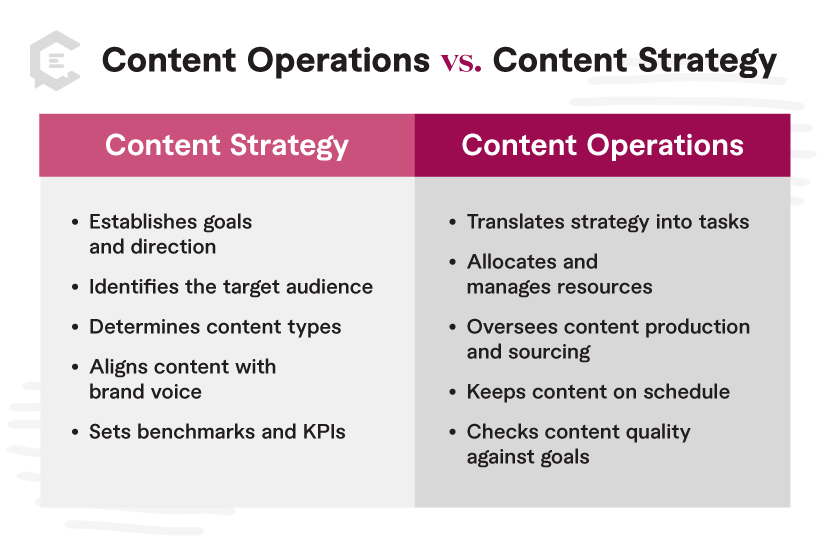 Source
SourceBefore we go further, let’s clear up confusion I hear constantly: What’s the difference between content strategy and content operations?
Content Strategy answers the big questions:
- Who are we creating for?
- What should we create?
- Why does this content matter to our audience and our business objectives?
- Where should we publish it across digital channels?
Content strategy is your roadmap. It’s the thinking work.
Content Operations answers the execution questions:
- How do we actually create this content efficiently?
- When does each piece get created, reviewed, and published?
- Who is responsible for each step in the content workflow?
- What tools and content processes make production smoother?
Content operations is your engine. It’s the doing work.
Here’s the easiest way to remember it: Strategy is the destination. Operations is the vehicle that gets you there.
You can have brilliant content strategies that never execute because your operations are a mess. Or efficient operations producing content that serves no purpose because there’s no strategy.
The magic happens when both work together. Most creators spend 90% of their time on strategy and 10% on operations. The successful ones flip that ratio.
The Four Pillars of Smart Content Operations for Creators
If you want to build a sustainable content business, you need to understand these four core pillars.
1. Strategy That Eliminates Guesswork
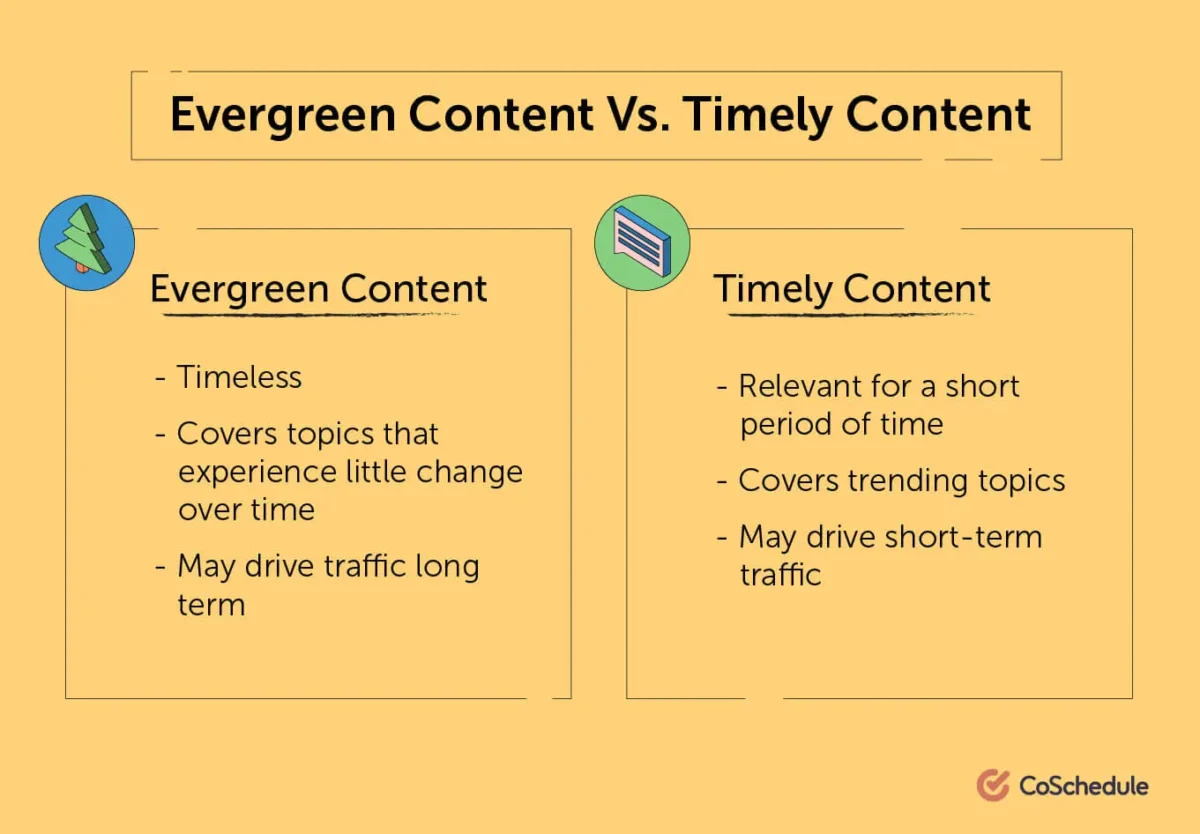 Source
SourceToo many creators produce and post reactively. They post when inspiration strikes or chase whatever’s trending. This approach makes everything harder over time and disconnects your content efforts from real business objectives.
Start by developing genuine audience understanding. Who are they? What problems keep them up at night? Why do they follow you instead of someone else? What does your customer want from you?
Then build a simple content calendar that balances two types of content:
- Evergreen content (valuable any time)
- Trending content (capitalizing on current conversations)
Most importantly, connect your content strategies directly to business goals through a clear messaging strategy. If you want to grow your email list, sell a course, or land sponsorships, every post you publish should support those objectives. Your stakeholders—whether that’s your audience, sponsors, or future customers—need to see clear value in what you create. This alignment between content marketing and business outcomes is what separates successful creators from those who struggle.
2. Workflow That Protects Your Energy
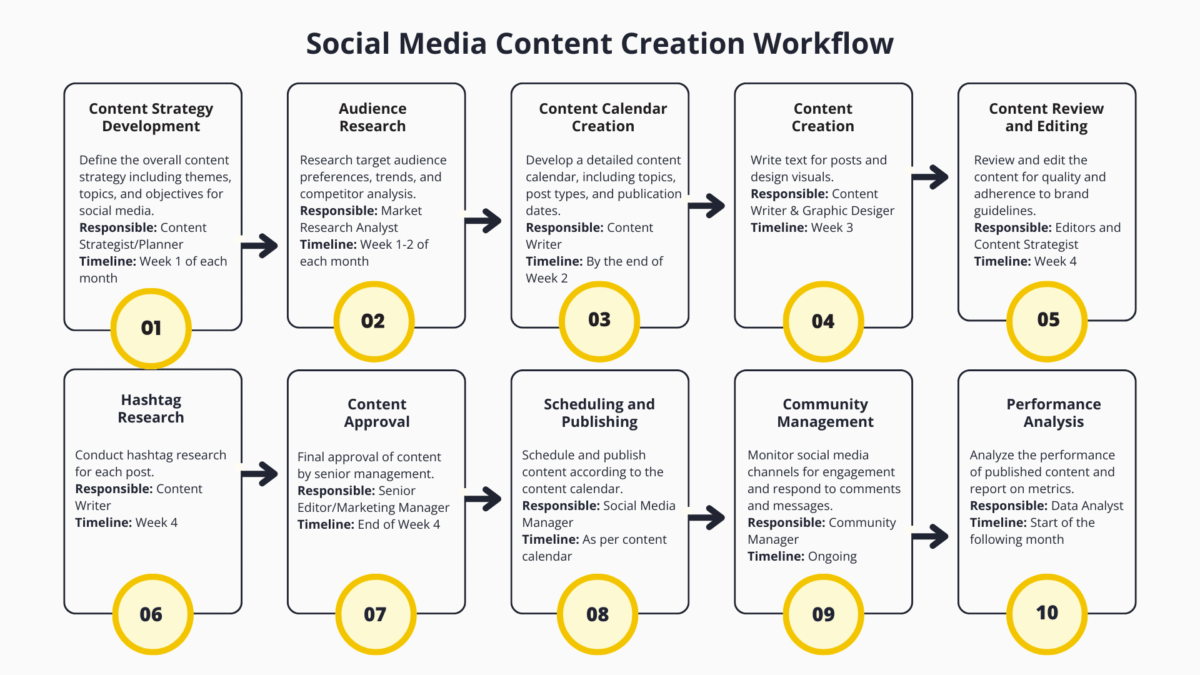 Source
SourceThink of this as building a mini production system. When you follow consistent processes throughout the content lifecycle—or what some call the digital lifecycle—everything becomes faster and smoother.
Start by documenting your current steps: research, drafting, editing, designing, publishing, and promotion. Even if you’re a one-person operation, create distinct “roles” for yourself. Monday you’re the Writer. Tuesday you’re the Editor. This mental separation helps your brain focus better and improves content optimization at each stage.
Batching is your best friend here. Do similar work in blocks: write three blog posts on Monday, edit all videos on Tuesday, schedule everything on Wednesday. This approach to content creation prevents context-switching fatigue and protects you from burnout. When you implement workflow automation for repetitive tasks like scheduling or file organization, you free up even more creative energy.
Technology should save you time—but only if you use it strategically. The goal is automating repetitive tasks while preserving more energy for producing high-quality content.
Automation: Use tools that schedule social media posts, organize assets, and send reminders so you’re not managing everything manually. This improves content delivery and ensures nothing falls through the cracks. Workflow automation tools can handle the boring stuff while you focus on creativity.
Digital Asset Management: When you’re creating content regularly, you accumulate lots of files—images, videos, templates, brand assets. A simple digital asset management system (even just organized folders in Dropbox or Google Drive) ensures you can find what you need instantly instead of wasting 20 minutes hunting for that one graphic.
Templates: Create reusable frameworks for captions, designs, and video scripts. This maintains consistency across your content management system while dramatically reducing decision fatigue.
AI Support: Artificial intelligence can help you draft, summarize, or repurpose content—but the creative thinking must stay yours. Your unique voice, perspective, and personality are what people actually follow. Use AI to enhance your content workflow, not replace your authentic messaging.
Choose the Right Stack: Keep it simple. Use Notion (which I use) for ideation, Trello (which I use for team collaboration), or Airtable for content planning and management. Use Buffer (which I use) for scheduling. And if you’re producing subscription-based content, platforms like OnlyMonster combine fan engagement, workflows, and analytics in one unified space.
Remember: fewer tools mean better focus. Don’t add apps just because other creators use them.
4. Data That Drives Smarter Decisions
Guessing is expensive. Real data shows you what’s working and where to improve, giving you actionable insights to refine your approach.
Track meaningful KPIs (Key Performance Indicators) like click-through rates, time on page, or revenue per post. Identify what actually generates income, whether it be course sales, memberships, sponsorships, or affiliate commissions. Look at which messaging resonates most with your audience and drives the customer experience you want to create.
Pay special attention to customer engagement metrics. Are people commenting, sharing, or taking action? These meaningful insights tell you far more than vanity metrics like follower counts. Track customer acquisition costs for your products or services so you know which content actually generates profitable contact with customers.
Don’t wait months to review performance. Build a simple reporting system in Google Sheets and check it weekly or monthly. This practice helps you stop wasting time on content that doesn’t serve your business objectives and focus more energy on what actually drives results.
Common Content Operations Challenges for Creators (And How to Fix Them)
Even when you understand content operations principles, implementation isn’t always smooth. Most creators face similar obstacles when building systems. These challenges are normal yet completely fixable with the right approach.
Fragmentation is the first major problem. Your content lives everywhere: ideas in one app, drafts in Google Docs, designs in Adobe Express, final videos in Dropbox. Too many places. This disorganization makes consistency nearly impossible and disrupts your entire content lifecycle. Without proper digital asset management, you waste hours just trying to locate files.
Solution: Choose one central hub—Notion or Airtable work well—where everything lives. This becomes your “home base” for content management. From initial idea to final publication, keep it all in one place. This organization creates clarity and saves countless hours while improving content delivery across all your digital channels.
Inconsistency comes next. Some weeks you publish frequently, other weeks you disappear. Your voice and quality fluctuate too much. This confuses your audience and erodes trust. People stop anticipating your content.
Solution: Create standardized systems. Use consistent file naming conventions, templates, and formats. Add one simple quality-check step before publishing. This ensures nothing goes live that doesn’t represent your brand well and maintains your messaging across all platforms. Inconsistent messaging is one of the fastest ways to lose audience trust.
Scaling is a hidden trap. As your audience grows, stakeholders expect more—more content, more value, faster responses. But your production process doesn’t evolve. It can’t keep up. You feel overwhelmed and start missing deadlines. Lots of people hit this wall when they’re trying to grow.
Solution: Master batching and repurposing. One comprehensive blog post can become five social media posts. One video can generate quote graphics, newsletter content, and short clips. Use your content efforts more strategically, not just more frequently. Smart content strategies multiply your output without multiplying your workload or customer acquisition costs.
Team Collaboration creates friction even with small teams. You hire an editor or assistant, but they don’t know what to do or when. Delays happen. You waste time re-explaining everything.
Solution: Define clear roles and responsibilities. Even with just two people, everyone needs to know who does what, when, and how. Use project management tools like Trello or Airtable to visualize task progress, feedback, and deadlines. No guessing allowed. Clear content processes eliminate confusion and improve efficiency.
Don’t expect perfection immediately. But when you consistently fix one small thing at a time, your content operations framework becomes progressively stronger.
Building Your Personal Content Operations Framework
Creating your own system doesn’t require fancy software or a large team. Start with what you’re already doing—then build from there.
Step 1: Audit Your Current Process
Examine how you work right now. Where do you capture ideas? How do you move from concept to published post? Where do you feel stuck or slow?
You don’t need a comprehensive report. Just observe yourself for one to two weeks. Track how much time you spend on writing, editing, and publishing. Maybe you’ll discover thumbnails take too long. Or perhaps rewriting similar captions repeatedly eats your time. This simple audit reveals what’s working and what needs improvement in your content creation workflow, giving you valuable insights into where bottlenecks exist.
This audit also helps you identify where artificial intelligence or workflow automation could help most. Don’t automate everything—just the repetitive tasks that drain your energy without adding creative value.
Step 2: Map Out Your Ideal Workflow
After your audit, design your ideal process. Consider your main content types—short videos, long-form blog posts, newsletters, social updates. For each format, document the steps. Most content follows similar phases throughout the content lifecycle:
- Ideation and planning
- Creating the draft
- Review and editing
- Publishing
- Promotion and distribution
Next to each step, note which tool you use (Google Docs, Trello, Canva) and approximately how long it takes. Even if you’re working solo, documenting this helps. When you eventually hire help, they can follow your existing system instead of you explaining everything from scratch. This clarity in content processes makes scaling much smoother.
Think about where you maintain contact with customers throughout this workflow. Are you responding to comments? Engaging in DMs? Building deeper insights about what your audience actually wants? Build these touchpoints into your documented process.
Step 3: Choose Your Tech Stack Strategically
Now that you understand your process, select tools that actually support it. Don’t choose apps just because other content creators recommend them. Use what helps you move faster and serves your organization’s needs.
For planning? Try Notion, Trello, or Airtable. For scheduling posts? Buffer or Hootsuite work well. For content management systems? Choose based on your specific platform needs. For digital asset management? Even basic cloud storage with good organization works.
Remember: fewer tools equal better focus. Tool bloat kills productivity and disrupts content optimization.
Step 4: Set Up Analytics Feedback Loops
You don’t need sophisticated analytics. But you do need basic tracking. Choose one to two metrics that matter for your business. Maybe it’s email signups. Maybe it’s video views or comment engagement. Maybe it’s revenue per post or customer acquisition.
Use a simple Google Sheet or dashboard. Don’t wait for “massive success”—just track weekly or monthly. You’ll quickly see what’s working and what isn’t. These insights transform you from someone who guesses to someone who makes informed decisions based on real customer behavior and content marketing performance.
Look for meaningful insights beyond surface-level metrics. Which content drives customer engagement? What messaging strategy resonates most? Which digital channels deliver the best ROI? This deeper audience understanding transforms your entire approach.
Step 5: Iterate Continuously
Your system is never “finished.” It evolves as you grow.
Every few weeks, pause and evaluate:
- What part feels slow or frustrating?
- What tasks drain your energy?
- Can you eliminate, automate, or delegate any steps?
Even small changes—like implementing templates or outsourcing one task—can save hours each week. Cut what drains you. Double down on what delivers results. Your content operations framework should grow with you, not constrain you.
Content Operations Best Practices to Work Smarter, Not Harder
Once you’ve built your basic system, even if it’s imperfect, you can focus on maximizing efficiency. These best practices aren’t rigid rules—they’re proven habits that help you conserve energy, maintain consistency, and create high-quality content without burning out.
Standardize Everything: Use identical file naming conventions, tags, and templates every time. When you do this, you never waste mental energy thinking, “Where did I save that graphic?” or “Which font should I use?” Even when you’re exhausted, your system keeps you moving forward. This also makes onboarding any future content teams dramatically easier.
Master the Art of Repurposing: Don’t create brand-new content from scratch every time. Start with one substantial piece—a comprehensive blog post or podcast episode. Then break it into smaller components: pull quotes, tweets, short video clips, carousel posts. This gives you more content with significantly less effort while maintaining consistent messaging. Your audience benefits from seeing your message in multiple formats that suit their preferences across different digital channels.
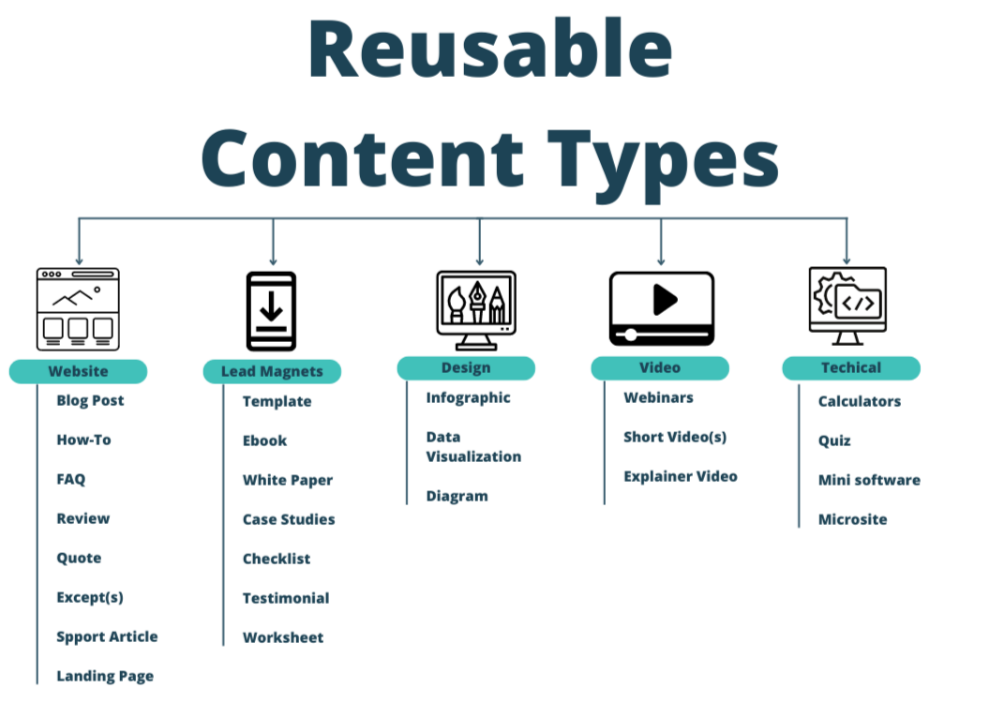 Source
SourceCreate “Content Kits”: If you frequently launch products or discuss recurring topics, build ready-to-use template folders. Include branded images, sample captions, links, and hashtags. Next time you launch something, you don’t start from zero—you just customize the kit and publish faster. This eliminates decision fatigue and streamlines your entire content workflow.
Keep Human Creativity Central: AI is a powerful tool, but it’s not a complete solution. Use artificial intelligence to accelerate drafting or generate ideas—but never let it replace your authentic voice. Your unique perspective, humor, cultural insights, and personality are why people follow you. AI helps you work faster, but you must stay in control. Your stakeholders connect with you, not algorithms.
Prioritize Energy Management: You’re not a machine. Even with perfect systems, some days you’ll feel depleted. That’s normal. Use batching to avoid daily grinding—create multiple posts in one focused session, then take breaks. Work during your peak energy hours and protect time for genuine rest. Burnout is real, and no amount of organization can prevent it if you ignore your limits. Smart content operations should protect your energy, not consume it.
Your 4-Week Content Operations Quick Start Checklist
Ready to build your system? Here’s exactly where to start. Don’t try to do everything at once—follow this timeline and build one piece at a time.
Week 1: Audit & Observe
- Track your time for 5 days (write down every content-related task and how long it takes)
- List all the places your content currently lives (tools, apps, folders)
- Identify your 3 biggest time wasters (what tasks drain you most?)
- Note which content has performed best in the last month (customer engagement, sales, growth)
- Assess your current audience understanding (do you really know what your customer wants?)
Week 2: Choose Your Foundation
- Select ONE central planning tool (Notion, Trello, or Airtable—pick one and commit)
- Set up basic folder structure for digital asset management (organized by content type or date)
- Create a simple content calendar for the next two weeks across your key digital channels
- Document your current content workflow for your #1 content type (just write down the steps)
- Identify one area where workflow automation could save you time
Week 3: Build Your First Systems
- Create 3 content templates (caption structures, video scripts, or email formats)
- Set up one workflow automation (scheduling tool, reminder system, or file backup)
- Batch create content for next week (try creating 3-5 pieces in one sitting)
- Establish 2 metrics you’ll track weekly (focus on meaningful insights, not vanity metrics)
- Define your core messaging strategy (what consistent message do you want to communicate?)
Week 4: Test & Refine
- Use your new systems exclusively for one full week
- Note what feels easier and what still feels clunky
- Adjust one thing that isn’t working (don’t rebuild everything—just tweak)
- Review your contact with customers (are you creating opportunities for genuine engagement?)
- Schedule your next monthly review date (make this a recurring calendar event)
After Week 4: Keep improving one small thing each week. Maybe you add another template. Maybe you automate another repetitive task. Maybe you refine your messaging based on the deeper insights you’re collecting from your analytics.
The goal isn’t perfection in 30 days. The goal is having a foundation you can build on, week after week, without burning out. Lots of people try to overhaul everything at once and quit within two weeks. Don’t be one of them.
Start with Week 1 tomorrow. Just observe and track. You’ll be surprised what insights emerge when you simply pay attention to how you’re actually spending your time throughout the content lifecycle.
Final Thoughts: Smarter Systems, More Creative Freedom
For many creators, the word “operations” sounds corporate. Maybe too professional. Like it belongs in a traditional office environment, not in creative work.
But that’s not accurate.
A well-designed system doesn’t kill creativity, it actually helps protect it. It gives you more time to think, write, film, design, and genuinely connect with your audience. It eliminates the daily panic of “What should I post today?” or “Did I forget to publish something?”
When you build even a simple content operations framework—just a few documented content processes, a few strategic tools—your mind can relax. You don’t work harder. You work smarter. You deliver better customer experiences because you’re not constantly stressed.
And here’s what I know from experience: content operations will only become more essential as the creator economy evolves. The tools are getting better—AI is becoming more accessible, platforms are consolidating features, and data is getting easier to understand. But the creators who win won’t be the ones with the fanciest tools. They’ll be the ones who built solid systems early and used technology strategically, not reactively.
You don’t need to wait for the perfect moment or the perfect tool. You don’t need to fix everything this week. Start small. Choose one tool that saves time. Track one metric that indicates success. Or document one content workflow so you don’t have to reinvent it next time.
This is how successful creators actually grow: one smart habit at a time. One small system. Then another. Building sustainable content operations isn’t just a business decision—it’s the best creative decision you can make.
This is a post inspired by input from one of my marketing partners. All opinions are 100% my own.
Actionable advice for your digital / content / influencer / social media marketing.
Join 13,000+ smart professionals who subscribe to my regular updates.